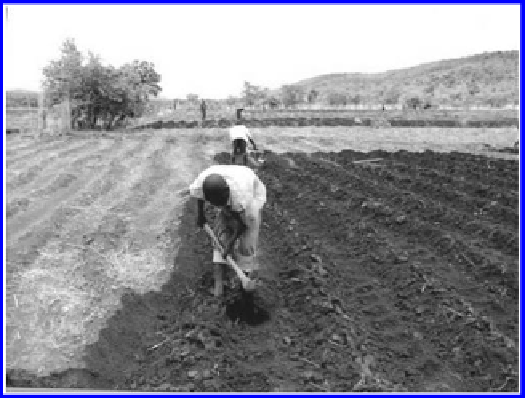Agriculture Reference
In-Depth Information
Adoption of CA in Zambia also clearly has a gender dimension. Men are mostly
involved with ripping, while women are engaged with digging of basins. The basins
are dug with a hoe (chaka hoe) that is considerably heavier than the traditional hoe.
Women find it difficult to work with the chaka hoe for long periods, and there is
therefore a clear limit to how much land that can be tilled with the chaka hoe. Women
in Zambia are often responsible for clearing the land and weeding in the traditional
tillage system. CA changes the distribution of labor during the season, as less time
is needed to clear the land before sowing; however, the labor demand for weeding
increases if herbicides are not applied (Nyanga et al. 2011). There is also clearly a
gender issue related to plowing in Ethiopia, as it is socially unacceptable for women
to plow in this country.
There is also a considerable adoption of CA in Malawi (Figure 10.5). It is esti-
mated that by 2011, >63,000 farmers had practiced CA (Ministry of Agriculture
Irrigation and Water 2012). Both basins and direct sowing are practiced in Malawi.
Planting basins are commonly found on farms in Burkina Faso, and it is estimated
that between 30,000 and 60,000 ha are under planting basins (zai) in the country
(Sawadogo 2011).
Mulching is the principle of CA most difficult to adhere to (
Figure 10.6
). Free grazing
is practiced in most parts of sub-Saharan Africa, and improved grazing management
or zero grazing systems are therefore needed if this principle of CA is to be respected.
Livestock management should therefore be an integrated part of CA; however, most
development interventions focusing on CA have ignored this issue. It is therefore not
surprising that there has not been much progress on this issue. Crop rotation is often a
difficult recommendation to follow, as this option is a highly economic question.
Adoption of new technologies by smallholders in Africa is a complicated issue,
as farmer behavior is not only based on profit maximization but considerations as
drudgery and risk are also factors affecting uptake of new technologies. Other fac-
tors constraining the uptake of new technology are access to input, price of input and
FIGURE 10.5
Traditional tillage by using ridge splitting in Malawi.

